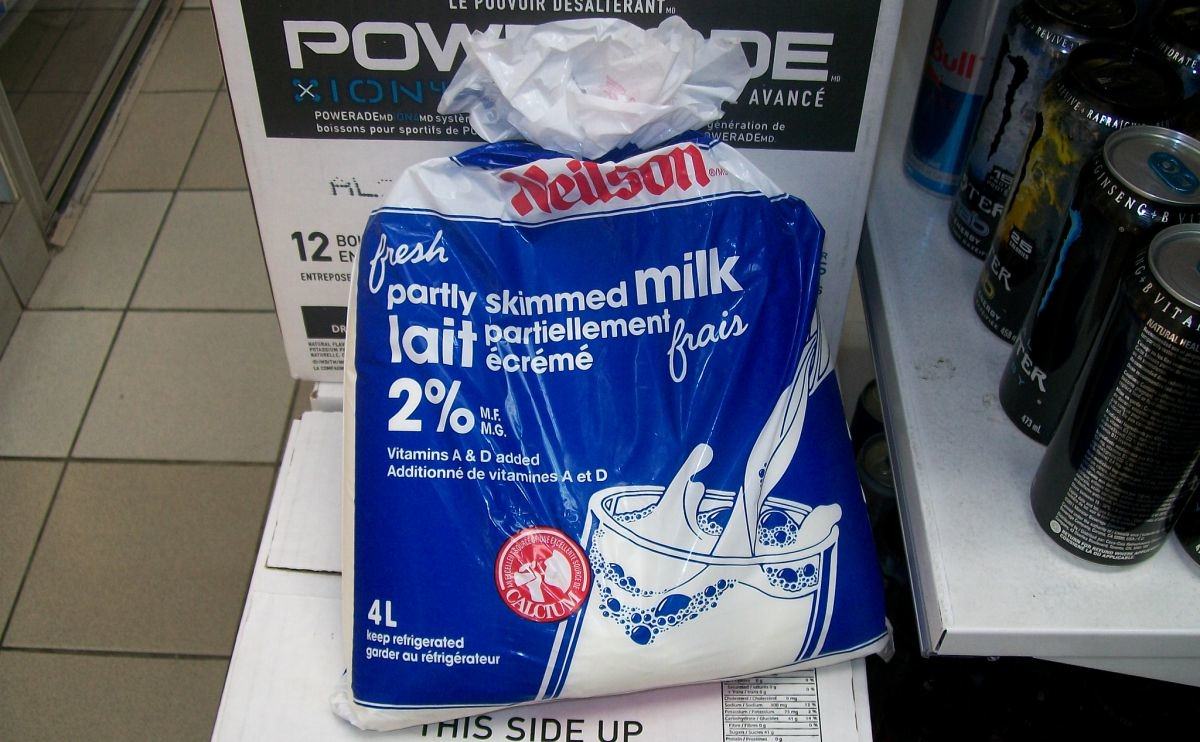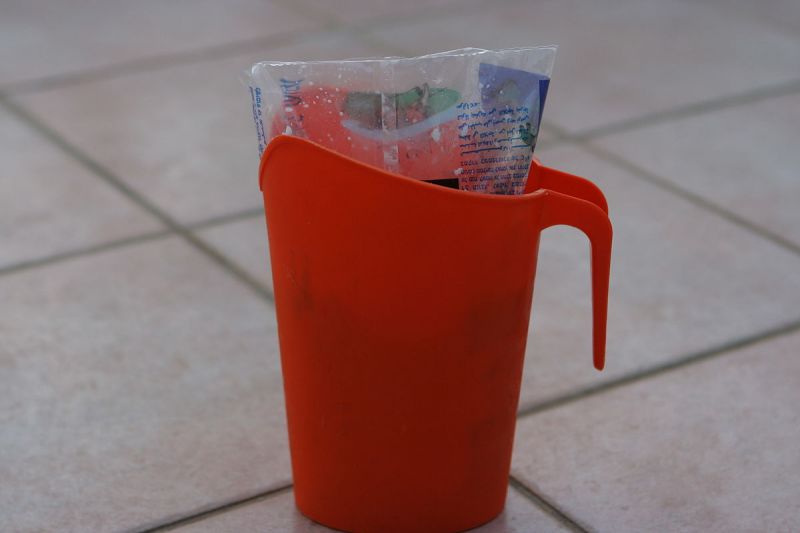What’s The Point Of Milk That Comes In Plastic Bags?
One school in Nebraska is trying to find out what Canadians love so much about bagged milk.
What’s The Point Of Milk That Comes In Plastic Bags?
One school in Nebraska is trying to find out what Canadians love so much about bagged milk.

Golden Hills Elementary School, near Omaha, Nebraska, changed all of its milk cartons to bagged milk this year, citing tests (done in-house) that kids were finishing more of their milk when it arrived in bags than when in cartons. Golden Hills is the latest in a long line of worldwide experiments with bagged milk, some more successful than others.
In the mid-1990s, Philadelphia schools briefly tried out bagged milk. (My elementary school, in the western suburbs of the city, also gave it a shot.) Both regular and chocolate milk would arrive in clear plastic pouches, with no obvious way to open them. Provided alongside the pouch was a short yellow straw, narrower and shorter than a typical straw, and with a sharpened point on one end. It took a bit of practice to figure out the trick; you had to cover the blunt end of the straw with your thumb while stabbing into the pouch, otherwise milk would fly out.
In eastern Canada, from Ontario through Quebec and into the less-populated Maritime provinces, bagged milk is the norm, but not in personal-sized pouches. Canadians buy their milk in a large bag, which contains three smaller bags packed full of milk. All three bags together equal four liters of milk. When you want some, you carefully insert the bag into a plain pitcher and snip off the corner of the bag. There is no way to close it, though I suppose it’s technically possible to fold it over.
This practice is bizarre to Americans. But our own solutions – cardboard cartons and plastic jugs – are fairly new, according to various histories, like The Atlantic‘s nice history of the carton. Up until the late 1960s, milk arrived in heavy glass bottles, which were both easy to use and to reuse. But they were also heavy, which added to transport costs, and prone to breakage, so around the 1960s, alternatives began popping up. In Canada, DuPont introduced bagged milk in 1967, around the same time that other companies introduced plastic jugs and cardboard cartons, but they weren’t very popular until 1970, when Canada began its conversion to the metric system.

Everything in Canada, including milk, had to be rejiggered to be sold in metric units. No more quarts and gallons of milk: liters were the way to go. And it turned out that the thin plastic bags used for DuPont’s milk were extremely amenable to size changes. It was no problem at all to seal the bags in a different spot to make them metric-compliant. Jugs and cartons, on the other hand, had to be redesigned and manufactured from scratch, a significant disadvantage. They never really succeeded in making up for lost time, and bagged milk now reigns in Canada.
The obvious question, though, is why Canadians have put up with the bagged milk for so long. It requires extra equipment (scissors and a pitcher), it can’t be resealed and so goes bad quickly, and it’s prone to spilling if cut or poured incorrectly. There are also environmental downsides; in much of Canada, the bags aren’t recyclable, unlike the jugs or cartons. So what’s the deal?
Bagged milk does, of course, have a few benefits. For one, you’re opening a smaller amount of milk at a time, so even though the opened bag does go bad faster, the remaining sealed bags in your 4-liter three-pack stay good for much longer. For another, bagged milk tends to be a little big cheaper, simply because plastic bags are cheaper to make than cardboard cartons or plastic jugs.
Golden Hills’ experiment is a curious one: The food service director for the school thinks kids drink more of the bagged milk because, unlike with cartons, they can see exactly how much they’ve drunk. I can find no study to indicate whether bags or cartons tend to result in more milk drunk, but sure, why not? I do remember liking the weird little milk pouches.
Follow us
This work is licensed under a Creative Commons Attribution-NoDerivatives 4.0 International License.
Want to republish a Modern Farmer story?
We are happy for Modern Farmer stories to be shared, and encourage you to republish our articles for your audience. When doing so, we ask that you follow these guidelines:
Please credit us and our writers
For the author byline, please use “Author Name, Modern Farmer.” At the top of our stories, if on the web, please include this text and link: “This story was originally published by Modern Farmer.”
Please make sure to include a link back to either our home page or the article URL.
At the bottom of the story, please include the following text:
“Modern Farmer is a nonprofit initiative dedicated to raising awareness and catalyzing action at the intersection of food, agriculture, and society. Read more at <link>Modern Farmer</link>.”
Use our widget
We’d like to be able to track our stories, so we ask that if you republish our content, you do so using our widget (located on the left hand side of the article). The HTML code has a built-in tracker that tells us the data and domain where the story was published, as well as view counts.
Check the image requirements
It’s your responsibility to confirm you're licensed to republish images in our articles. Some images, such as those from commercial providers, don't allow their images to be republished without permission or payment. Copyright terms are generally listed in the image caption and attribution. You are welcome to omit our images or substitute with your own. Charts and interactive graphics follow the same rules.
Don’t change too much. Or, ask us first.
Articles must be republished in their entirety. It’s okay to change references to time (“today” to “yesterday”) or location (“Iowa City, IA” to “here”). But please keep everything else the same.
If you feel strongly that a more material edit needs to be made, get in touch with us at [email protected]. We’re happy to discuss it with the original author, but we must have prior approval for changes before publication.
Special cases
Extracts. You may run the first few lines or paragraphs of the article and then say: “Read the full article at Modern Farmer” with a link back to the original article.
Quotes. You may quote authors provided you include a link back to the article URL.
Translations. These require writer approval. To inquire about translation of a Modern Farmer article, contact us at [email protected]
Signed consent / copyright release forms. These are not required, provided you are following these guidelines.
Print. Articles can be republished in print under these same rules, with the exception that you do not need to include the links.
Tag us
When sharing the story on social media, please tag us using the following: - Twitter (@ModFarm) - Facebook (@ModernFarmerMedia) - Instagram (@modfarm)
Use our content respectfully
Modern Farmer is a nonprofit and as such we share our content for free and in good faith in order to reach new audiences. Respectfully,
No selling ads against our stories. It’s okay to put our stories on pages with ads.
Don’t republish our material wholesale, or automatically; you need to select stories to be republished individually.
You have no rights to sell, license, syndicate, or otherwise represent yourself as the authorized owner of our material to any third parties. This means that you cannot actively publish or submit our work for syndication to third party platforms or apps like Apple News or Google News. We understand that publishers cannot fully control when certain third parties automatically summarize or crawl content from publishers’ own sites.
Keep in touch
We want to hear from you if you love Modern Farmer content, have a collaboration idea, or anything else to share. As a nonprofit outlet, we work in service of our community and are always open to comments, feedback, and ideas. Contact us at [email protected].by Dan Nosowitz, Modern Farmer
October 20, 2015
Modern Farmer Weekly
Solutions Hub
Innovations, ideas and inspiration. Actionable solutions for a resilient food system.
ExploreExplore other topics
Share With Us
We want to hear from Modern Farmer readers who have thoughtful commentary, actionable solutions, or helpful ideas to share.
SubmitNecessary cookies are absolutely essential for the website to function properly. This category only includes cookies that ensures basic functionalities and security features of the website. These cookies do not store any personal information.
Any cookies that may not be particularly necessary for the website to function and are used specifically to collect user personal data via analytics, ads, other embedded contents are termed as non-necessary cookies.
you wrote big cheaper instead of a bit cheaper
Eh, the open bag spoiling quicker is very easy to fix. Just use a little clip and it’ll spoil slower than your not-really-sealed carton.
Can’t lift the heavy 4L jug and it spoils quickly. The smaller bags of milk get used up (then recycled) and are then not taking up fridge space like a big jug would.
I am Canadian. I actually hate bagged milk. We do have the option of buying milk in jugs in certain corner stores. Milk bags can leak and the top of the bag can flop over if you are pouring milk into your tea, etc. causing the milk to spill. Every time this happens I end up cursing them…lol. Milk doesn’t last long enough in our house for it to go bad. And, those little clipped plastic corners are a pain… especially when certain family members fail to dispose of them. They can be a choking hazard for little ones.
I was a Canadian combat engineer and i always loved the fact that the water purification machine we have for emergency help has a the same bagger so when we go to place like the Philippines after the typhoon, we give them bagged water and they ways look at us like what the heck do i do with this.
Ps: i love bagged milk.
You could use a bulldog clip or a Japanese clip to reseal
Some of the stores in my state (WI) have pitchers with a little hook looking tip (free when you buy a bag of milk) that lets you fold the corner of the bag into itself which is kind of nice and keeps from any spills
All I can see in my head is leaks & spills. Even Ziplock is far fom air-tight, so I assume faster spoilage. Plastic milk cartons & plastic bags leak horrid chemical flavors into milk & sandwiches, so I can’t imagine the taste being good.